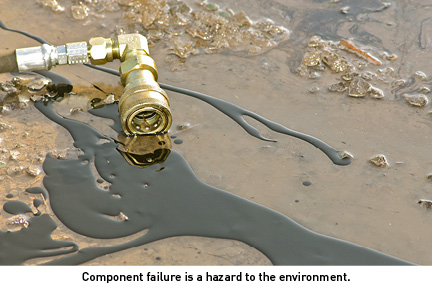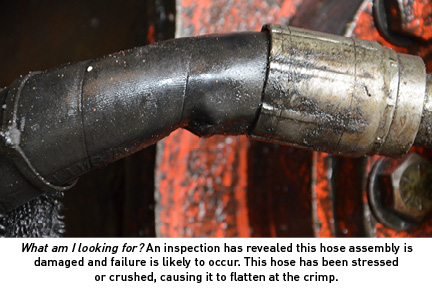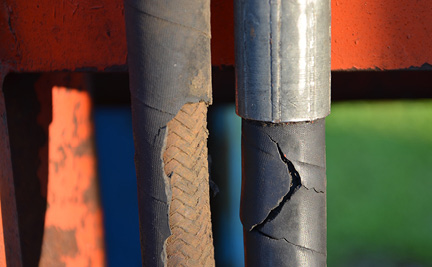Hydraulics and the Environment

Component failure is often the root cause of hydraulic spills to the environment. In this article, we won’t discuss environmentally friendly fluids, but instead lean more toward the effects of failure and prevention.
Spill control methods for hydraulic failure are containment, adsorbents, and establishing protocols. Stepping back to the root cause is where we should focus in an effort to prevent failure and the use of these post controls. Hydraulic component failure is inevitable if you let it happen, however, it is also preventable. A hydraulic component will never get more reliable after its first use; in fact, the moment it is put to use, its life expectancy declines. There is a whole profession and organization that focuses on component and machine reliability, and these reliability experts convey that knowledge and comprehensive maintenance procedures will reduce failures by 90%. Every minute in North America, a hydraulic hose will fail, expelling hydraulic fluid to the surrounding environment. Even if the lost fluid is contained and the area is remediated, the lost fluid should never be returned to the system due to contamination.

This lost fluid, however, can be recycled, but in most cases, the fluid and adsorbents end up in landfill sites for natural breakdown. There is really no upside to component failure and release to the environment. HSAC recently released a safety poster titled “Near Miss,” which simply states: “If an injury did not result…it’s a reportable near miss.” The image on the poster is a failed hose assembly. We believe recording hydraulic hose failures in the near-miss category will eventually bring this phenomenon real serious attention, as it should! Hydraulic component manufacturers are very good at explaining reliability and the requirements of maintaining a failure-free system.
These pointers from manufacturers become industry best practices, which we hope will eventually be adapted into a standard. For more information on containment, adsorbents, biodegradable fluid, spills reporting, and effects on the environment, contact info@hsac.ca.
Answer: When the outer shell of a hydraulic hose has been damaged or has begun to break down, exposing the wire reinforcement, the steel wire immediately begins to corrode. The inner layer of rubber has no strength without sound wire reinforcement. Any hoses that are damaged should be replaced.
There is no act or standard that states you must replace the hose, however, legal repercussions can result in the event of a failure causing injury or death, including property and environmental damage. Liability may fall on the persons, supervisor, and company responsible for using components that are visibly damaged where the manufacturer and industry best practices state that they are not safe. A “fraying” hose is not safe and can fail at any time. The overall costs are much higher when failure occurs.

* The above articles have been reprinted with permission. Images courtesy of Hydraulic Safety Authority of Canada, Inc.



I handle used machinery. I experienced a lot of hydraulic failures in this industry. In many instances, boxes only interested to do breakdown repairs. Everybody wanted to save cost. I agree it is penny wise pound foolish situation and also shortage of hands on hydraulic workers because it is dirty, tough & dangerous work.
very useful article. apart from visual hose damage, the crimping process and the dimensional and metallurgical properties of the fittings contribute to fluid spillage and associated safety issues.
Excellent way of describing, and good post to obtain data concerning my presentation focus, which i
am going to deliver in academy.
Great article to highlight the safety and environment concerns related to component failures. As mentioned in your article, the small investment that it takes to replace a component pales in comparison to the damage that can occur to your expensive equipment or to he environment.